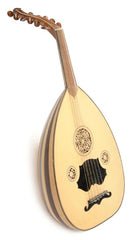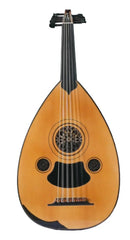The guitar, with its melodious strumming and soul-stirring chords, has captured the hearts of music enthusiasts for centuries. In this blog, we'll delve into the fascinating history of the guitar and explore the journey of this iconic instrument from its humble beginnings to the diverse range of guitars we know today. The significance of the guitar as a musical instrument lies not only in its ability to evoke powerful emotions but also in its pivotal role in shaping the sound of modern music.
Significance of the Guitar:
The guitar's significance as a musical instrument can be summarized in its versatility and universality. It transcends cultural boundaries, connecting people through the universal language of music. Whether it's the acoustic guitar's soothing strumming by a campfire, the electric guitar's electrifying solos at a rock concert, or the classical guitar's intricate fingerpicking in a symphony, the guitar has a place in nearly every genre and setting.
Its portability allows musicians to take their art wherever they go, making it a true companion in life's journey. From folk songs to classical compositions, blues to rock 'n' roll, and from intimate gatherings to grand stages, the guitar has left an indelible mark on the world of music.
The guitar's evolution is a testament to human ingenuity, craftsmanship, and the unending quest to create beautiful sounds. Join us as we travel through time to uncover the remarkable story of the guitar, from its modest origins to becoming an iconic symbol of musical expression.
The Early Origins of Stringed Instruments
Before the modern guitar, the world of stringed instruments had a rich and diverse history. These early precursors paved the way for the development of the guitar as we know it today. Two of the most notable precursors were the lute and the oud.
The Lute

The lute, with its rounded body and a fretted neck, is often considered a direct ancestor of the guitar. It originated in the Middle East and can be traced back to ancient Mesopotamia around 2000 BC. The lute's design evolved over time, and it was widely used in Europe during the Middle Ages and the Renaissance. The instrument's popularity led to the creation of various regional variations, like the Arabian 'oud' and the European 'lute,' each with distinct characteristics and playing techniques.
The lute's influence on the guitar can be seen in its use of frets on the neck, which facilitated the creation of different notes. The lute was plucked with the fingers, foreshadowing the fingerstyle technique later employed by classical guitarists.
The Oud:

The oud, on the other hand, is an ancient stringed instrument that holds a special place in the musical history of the Middle East and North Africa. The oud is similar in shape to the lute but typically has a smaller, more pear-shaped body. It dates back to as early as 5000 years ago and was widely used in various Islamic cultures, contributing to the development of diverse musical traditions.
The oud, with its fretless fingerboard and a unique tuning system, introduced musicians to a different way of creating music. It influenced the development of the 'maqam' system, which laid the foundation for the intricate melodic structures found in Middle Eastern music.
These early stringed instruments, including the lute and oud, were essential predecessors that played a vital role in shaping the design, techniques, and music theory that would eventually give birth to the modern guitar. As we move forward in time, we will discover how the guitar emerged from these roots to become a musical icon that transcends borders and genres.
The Emergence of the Modern Guitar
The journey from early stringed instruments to the modern guitar is a tale of innovation, cultural exchange, and artistic evolution. Central to this transformation was the "guitarra" during the Renaissance in Spain.
Transition to the Modern Guitar:
As the medieval era gave way to the Renaissance, stringed instruments underwent significant changes. The guitar's evolution can be traced through various designs, such as the vihuela, which featured six or more strings and a shape more reminiscent of the modern guitar. These instruments laid the groundwork for the emergence of the true "guitar."
The transition from earlier instruments to the modern guitar was marked by the adoption of standardized tuning, the introduction of gut strings, and the development of increasingly sophisticated construction techniques. The guitar began to take its contemporary form with a familiar body shape and frets that allowed for more precise note placement. These innovations made the instrument more accessible and versatile, leading to its widespread popularity.
The Role of the "Guitarra" in Renaissance Spain:
During the Renaissance, the Iberian Peninsula, particularly Spain, played a pivotal role in the guitar's development. The "guitarra," as it was known in Spain, was a six-stringed instrument that closely resembled today's classical guitar. It was favored by musicians and composers of the time.
 One of the most influential developments was the work of Spanish composer and vihuela player Luis de Narváez, who published "Los seys libros del Delphín" in 1538. This seminal work featured music specifically composed for the guitarra, marking one of the earliest collections of music for a six-stringed instrument. Narváez's compositions showcased the guitarra's expressive capabilities and laid the foundation for the instrument's role in classical music.
One of the most influential developments was the work of Spanish composer and vihuela player Luis de Narváez, who published "Los seys libros del Delphín" in 1538. This seminal work featured music specifically composed for the guitarra, marking one of the earliest collections of music for a six-stringed instrument. Narváez's compositions showcased the guitarra's expressive capabilities and laid the foundation for the instrument's role in classical music.
The "guitarra" became an emblem of Spanish culture, and its popularity continued to grow throughout the Renaissance. It played a prominent role in courtly and popular music, demonstrating its adaptability to various musical styles and settings.
The emergence of the modern guitar was a culmination of centuries of musical experimentation and craftsmanship, with the Spanish "guitarra" of the Renaissance serving as a crucial stepping stone. The guitar's continued evolution would see it embraced by musicians worldwide, transcending cultural and geographic boundaries to become the universal instrument we cherish today.
Antonio de Torres: The Father of the Modern Classical Guitar
 Antonio de Torres, a name synonymous with innovation and craftsmanship, stands as a prominent figure in the history of the guitar. Born on June 13, 1817, in Almería, Spain, Torres would go on to revolutionize the design and construction of the classical guitar, earning him the title "The Father of the Modern Classical Guitar."
Antonio de Torres, a name synonymous with innovation and craftsmanship, stands as a prominent figure in the history of the guitar. Born on June 13, 1817, in Almería, Spain, Torres would go on to revolutionize the design and construction of the classical guitar, earning him the title "The Father of the Modern Classical Guitar."
Innovations by Antonio de Torres:
- Radical Redesign: During the 19th century, the classical guitar was still evolving from its earlier incarnations. Torres, with his keen understanding of acoustics, made significant changes to the guitar's design. He enlarged the body, which led to improved resonance and projection. This innovation greatly enhanced the guitar's tonal qualities, making it more suited to both intimate settings and larger concert halls.
-
Fan Bracing: Torres introduced the fan-bracing system, which involved a delicate arrangement of struts beneath the soundboard. This bracing pattern improved the guitar's structural stability while allowing for better soundboard vibration. It's a design element still used in classical guitars today.
-
Innovative Soundholes: Torres incorporated the now-iconic rosette designs and soundhole shapes, which not only added to the guitar's aesthetics but also contributed to its improved tonal balance.
-
Varnish Techniques: Torres experimented with various varnishing methods, achieving a smoother and more resonant finish for his instruments. This contributed to the guitar's improved projection and tone.<
Influence on the Classical Guitar:
Antonio de Torres' innovations revolutionized the classical guitar and played a significant role in shaping the instrument's modern form. His designs set a new standard for construction, sound quality, and playability. The Torres guitar became the blueprint for what we recognize as the classical guitar today.
Torres' influence extended far beyond the workshop. His instruments were highly sought after by prominent musicians of the time, including Francisco Tárrega and Emilio Pujol, who contributed to the popularization of the classical guitar. Torres' work also influenced the design of other types of guitars, including the steel-string acoustic guitar.
The legacy of Antonio de Torres endures in the world of classical music, with his guitars commanding high prices at auctions and being cherished by musicians and collectors alike. His contributions to the classical guitar's development continue to shape the instrument's sound and aesthetics, making him a true luminary in the realm of music and craftsmanship. Antonio de Torres remains a celebrated figure and an inspiration for luthiers and guitarists around the globe.
The Birth of the Acoustic Guitar
The birth of the acoustic guitar is a fascinating journey that took place over several centuries, with significant contributions from luthiers like Christian Frederick Martin, whose name is synonymous with high-quality acoustic guitars.
Development of the Acoustic Guitar:
The development of the acoustic guitar can be traced back to the early Renaissance and Baroque eras, as it evolved from earlier stringed instruments like the lute and vihuela. By the 19th century, the acoustic guitar had already made significant advancements in design and construction, thanks to innovative luthiers.
Contributions of C.F. Martin:

Christian Frederick Martin, a German-American luthier, played a pivotal role in shaping the modern acoustic guitar. In 1833, he founded C.F. Martin & Company in Nazareth, Pennsylvania, and introduced a range of innovations that revolutionized the instrument:
-
X-Bracing: Martin's introduction of X-bracing, where two braces intersect beneath the soundboard, greatly enhanced the guitar's structural integrity while allowing the top to vibrate more freely. This innovation is still a standard feature in most steel-string acoustic guitars, contributing to their distinctive tone.
-
Dreadnought Design: Martin developed the iconic "dreadnought" body style, characterized by its large, square shoulders and a wider lower bout. The dreadnought design produced a powerful, resonant sound that was well-suited for both fingerpicking and strumming, making it a popular choice for folk, country, and bluegrass musicians.
-
Steel-String Guitars: Martin transitioned from traditional gut strings to steel strings, further enhancing the guitar's volume and projection. This change was crucial in the evolution of acoustic guitar music styles in the late 19th and early 20th centuries.
-
Quality Craftsmanship: Martin was renowned for his dedication to craftsmanship and the use of premium materials. His commitment to quality made Martin guitars highly sought after by musicians and collectors alike.
Christian Frederick Martin's innovations and commitment to quality had a profound impact on the world of acoustic guitars. His company, C.F. Martin & Company, has continued to produce world-class instruments, and Martin guitars have been used by legendary musicians like Eric Clapton, Johnny Cash, and Bob Dylan.
The birth of the acoustic guitar, with contributions from luthiers like Christian Frederick Martin, marked a pivotal moment in the history of music. These instruments became the backbone of various musical genres and continue to be cherished for their rich tones, playability, and enduring craftsmanship.
The Advent of the Electric Guitar
The advent of the electric guitar marked a groundbreaking shift in the world of music, giving birth to new genres and revolutionizing the way we create and experience sound. Early attempts to electrify guitars, including George Beauchamp's magnetic pickup, and the introduction of the "Frying Pan" electric guitar by Adolph Rickenbacker were instrumental in this transformation.

George Beauchamp and the Magnetic Pickup:
In the 1920s, the desire for louder guitars in live performances led to experimentation with amplification techniques. George Beauchamp, an engineer and musician, partnered with National String Instrument Corporation to develop the first successful magnetic pickup for the guitar.
The magnetic pickup consisted of a coil of wire wound around a magnet, which, when placed under the guitar strings, converted the string vibrations into electrical signals. These signals could then be amplified, resulting in a louder and more controllable sound. This invention addressed the limitations of acoustic guitars in band settings and was a major breakthrough in electric guitar technology.
In 1931, Beauchamp and his colleagues formed the "Ro-Pat-In Corporation" (later renamed Rickenbacker) to produce electric guitars. However, it was Adolph Rickenbacker who would bring the electric guitar into the mainstream.
The "Frying Pan" by Rickenbacker:
In 1931, Rickenbacker, along with Beauchamp, introduced the "Frying Pan," often regarded as the world's first commercially successful electric guitar. Its name came from the resemblance of its circular aluminum body to a frying pan.
The "Frying Pan" featured a magnetic pickup and was a revolutionary concept at the time. The instrument's design laid the foundation for future electric guitars, with its single-coil pickup and solid body construction. This allowed for greater sustain and reduced feedback compared to traditional hollow-body electric guitars.
The success of the "Frying Pan" demonstrated the immense potential of electric guitars, particularly in the emerging jazz, blues, and country music scenes. Musicians could now produce a clean, consistent sound, even at high volumes, and explore new sonic possibilities.
The advent of the electric guitar, driven by the innovations of George Beauchamp and the introduction of the "Frying Pan" by Rickenbacker, forever changed the landscape of music. These early pioneers paved the way for the iconic electric guitars we know today, opening doors for artists to push the boundaries of creativity, composition, and performance in ways previously unimaginable.
Les Paul and the Solid-Body Electric Guitar

Les Paul, a name synonymous with innovation and virtuosity, played a pivotal role in the evolution of the electric guitar. His contributions not only revolutionized the instrument but also left an indelible mark on the world of music. Let's explore Les Paul's journey and the iconic Gibson Les Paul guitar.
Les Paul's Role in the Evolution of the Electric Guitar:
Les Paul, born Lester William Polsfuss in 1915, was not only a virtuoso guitarist but also an inventor and visionary. He was among the first to recognize the limitations of hollow-body electric guitars, which were susceptible to feedback issues at high volumes. In the 1940s, he began experimenting with solid-body guitar designs.
The Gibson Les Paul:
Les Paul's pioneering work in guitar design led to his collaboration with the Gibson Guitar Corporation, resulting in the creation of the legendary Gibson Les Paul model in 1952. This guitar broke new ground in several ways:
-
Solid Body: The Gibson Les Paul was one of the earliest commercially successful solid-body electric guitars. Its design, featuring a solid mahogany body, minimized feedback, enhanced sustain, and allowed for a rich, clean tone that could be pushed to new limits without distortion.
-
Humbucking Pickups: Les Paul's guitar featured the revolutionary humbucking pickups, which reduced interference and noise while delivering a warm and powerful sound. This innovation has become a standard feature in many electric guitars.
-
Versatile Sound: The Les Paul's design offered a remarkable tonal range, making it suitable for various musical genres. From the bluesy warmth of a neck pickup to the biting edge of a bridge pickup, it became a favorite among rock, blues, and jazz musicians.
-
Innovation in Recording: Les Paul was not only a guitar innovator but also a pioneer in the world of recording. He created the first multi-track recording, allowing for layering and overdubbing in music production. This groundbreaking technique transformed the way music was recorded and produced.
The impact of the Gibson Les Paul on the music industry was profound. The guitar became a symbol of rock 'n' roll, gracing the hands of legendary artists like Jimmy Page, Eric Clapton, and Slash, among many others. Its aesthetics, including the iconic single-cutaway design and sunburst finish, have made it an instantly recognizable classic.
Les Paul's influence extended far beyond the guitar; it shaped the very landscape of modern music. His dedication to innovation, his virtuosity as a musician, and his pioneering work in recording technology have left an enduring legacy. The Gibson Les Paul, with its timeless design and extraordinary sound, stands as a testament to Les Paul's indomitable spirit and his lasting impact on the world of music.
Leo Fender and the Fender Stratocaster

Leo Fender, a self-taught engineer and inventor, made revolutionary contributions to the design of electric guitars and amplifiers. His innovations laid the foundation for modern electric guitar manufacturing, and one of his most iconic creations, the Fender Stratocaster, stands as a testament to his lasting impact on the music industry.
Leo Fender's Contributions to Electric Guitar Design:
-
The Solid-Body Electric Guitar: In the early 1950s, Leo Fender introduced the world to the Telecaster, one of the earliest mass-produced solid-body electric guitars. This groundbreaking design was more durable and less susceptible to feedback compared to hollow-body guitars. It featured a bolt-on neck, which made repairs and adjustments easier, and it was designed for ease of assembly and mass production.
-
Single-Coil Pickups: Fender's guitars, including the Stratocaster, were among the first to incorporate single-coil pickups. These pickups offered a bright, clear tone with sharp attack and excellent articulation. The design provided a distinctive "twang" that became a hallmark of Fender instruments.
-
Tremolo System: Fender introduced the synchronized tremolo system, commonly known as the "whammy bar," which allowed players to create expressive pitch bends and vibrato effects. This feature added a new dimension to the electric guitar's sonic possibilities.
-
Bolt-On Neck: Fender's decision to use a bolt-on neck design allowed for easier repair and replacement, a design feature that became a signature of the Fender brand.
The Fender Stratocaster and Its Impact:
The Fender Stratocaster, introduced in 1954, is one of the most iconic and influential electric guitars ever created. Its innovative features set it apart:
-
Contoured Body: The Stratocaster featured a contoured body that improved player comfort and ergonomics, making it easier to play for extended periods.
-
Three Single-Coil Pickups: The Stratocaster's three-pickup configuration provided a wide tonal range, allowing players to achieve everything from sparkling cleans to biting overdrive.
-
Five-Way Pickup Selector: The Stratocaster's five-way pickup selector switch gave players access to more pickup combinations, further expanding their sonic options.
-
Tremolo System: The Stratocaster's tremolo system, often referred to as the "Strat trem," became synonymous with expressive dive bombs and pitch manipulation, significantly influencing rock and blues guitarists.
The Fender Stratocaster quickly gained popularity among musicians, including legends like Jimi Hendrix, Eric Clapton, and Stevie Ray Vaughan. Its versatile sound, sleek design, and durability made it a staple in various genres, from rock and blues to pop and beyond.
Leo Fender's innovations, including the Stratocaster, transformed the electric guitar into a versatile, accessible, and reliable instrument, contributing to the evolution of modern music. The Fender brand and the Stratocaster, in particular, remain iconic symbols of the electric guitar's enduring significance in the world of music.
The Continued Evolution of the Guitar
As we journey through the pages of guitar history, we find that the instrument has continued to evolve, adapt, and inspire musicians and luthiers alike. In this section, we'll explore the ongoing innovations in guitar design and technology, as well as the contemporary guitar makers and trends that shape the instrument's future.
Subsequent Innovations in Guitar Design and Technology:
-
Extended-Range Guitars: In recent years, extended-range guitars, such as 7, 8, and 9-string instruments, have gained popularity. These guitars offer extended lower registers, catering to genres like djent and progressive metal.
-
Digital Modeling and Effects: Advancements in digital technology have led to the creation of digital modeling amplifiers and multi-effects processors. These tools allow guitarists to emulate various amplifiers, effects pedals, and even acoustic guitar tones, all in a single unit.
-
Fan-Fret Guitars: Fan-fret or multi-scale guitars have varying scale lengths for each string. These designs improve intonation and string tension, making them ideal for extended-range instruments.
-
Ergonomic and Sustainable Materials: Some contemporary builders focus on ergonomic guitar designs for improved playability, along with sustainable materials to minimize the instrument's environmental footprint.
Contemporary Guitar Makers and Trends:
-
Custom Luthiers: A thriving community of custom guitar luthiers continues to push the boundaries of design and craftsmanship. These artisans create unique, one-of-a-kind instruments tailored to the specific needs and preferences of individual musicians.
-
Boutique and Small-Scale Builders: Boutique guitar makers produce limited quantities of high-quality instruments, often with a focus on craftsmanship and unique features. These guitars attract collectors and discerning players.
-
Vintage and Retro Revival: Many guitarists seek vintage or vintage-style instruments for their unique character and tonal qualities. Brands like Fender and Gibson continue to produce reissue models reminiscent of iconic vintage guitars.
-
Digital Connectivity: Guitars with built-in digital technology and wireless connectivity are on the rise. These instruments allow for seamless integration with recording software and digital effects, making them versatile tools for modern musicians.
-
Multiscale and Ergonomic Design: Innovations in guitar ergonomics, like ergonomic body shapes and multiscale fretboards, aim to improve comfort during long playing sessions.
-
Sustainability: The use of sustainable materials, such as reclaimed wood and eco-friendly finishes, is a growing trend in the guitar industry, reflecting a broader emphasis on environmental responsibility.
-
Hybrid Instruments: Some contemporary builders experiment with hybrid instruments that merge traditional guitar design with new technology, such as incorporating MIDI controllers and synthesizer capabilities into guitars.
The guitar's evolution is an ongoing journey, reflecting the changing needs and aspirations of musicians. Contemporary guitar makers and luthiers continue to explore new horizons, incorporating modern technology and sustainable practices while honoring the instrument's rich heritage. As the guitar community continues to grow, we can expect even more exciting developments in the world of guitar design, craftsmanship, and music.
Conclusion
The guitar, a marvel of musical invention, has captivated the world with its rich history, continual evolution, and enduring influence. This blog has explored the guitar's journey from its early precursors, like the lute and oud, to the visionary innovations of prominent figures like Antonio de Torres, Les Paul, and Leo Fender, each contributing to its transformation.
The guitar's evolution has always been a collaborative effort, with musicians, luthiers, and inventors working together to push the instrument's boundaries. It began as a modest stringed instrument and evolved into the diverse array of guitars we know today, such as the classical, acoustic, and electric guitar.
The enduring significance of the guitar cannot be overstated. It's a universal language, transcending borders and genres, uniting people with its melodies and chords. The guitar's impact reaches deep into the heart of music, from intimate campfire sing-alongs to electrifying rock concerts, from classical symphonies to the bluesy depths of human emotion.
The guitar's continued evolution, with innovations like extended-range guitars, digital modeling, and sustainable materials, illustrates its adaptability to changing times. Custom luthiers and boutique builders, driven by a passion for craftsmanship, ensure the instrument's timeless relevance. Vintage revival, digital connectivity, and ergonomic design represent a harmonious blend of the traditional and the contemporary.
As we conclude this journey through the history and evolution of the guitar, one thing remains clear: the guitar is more than an instrument; it is a cultural icon, a vessel for human expression, and a timeless companion in the world of music. Its enduring influence transcends generations and will continue to shape the soundscape of the future, celebrating the collaborative spirit of musicians and luthiers as they harmoniously blend the past with the present, making music that resonates with the soul.




Share:
An Ultimate Buying Guide for Premium Guitars
How to Tune an Electric Guitar